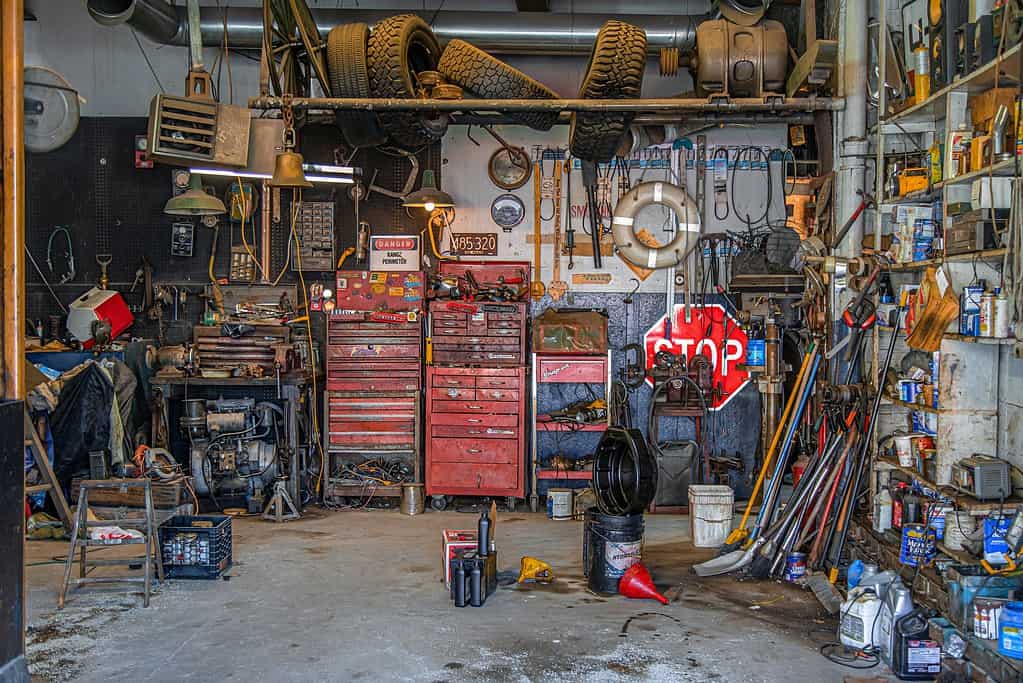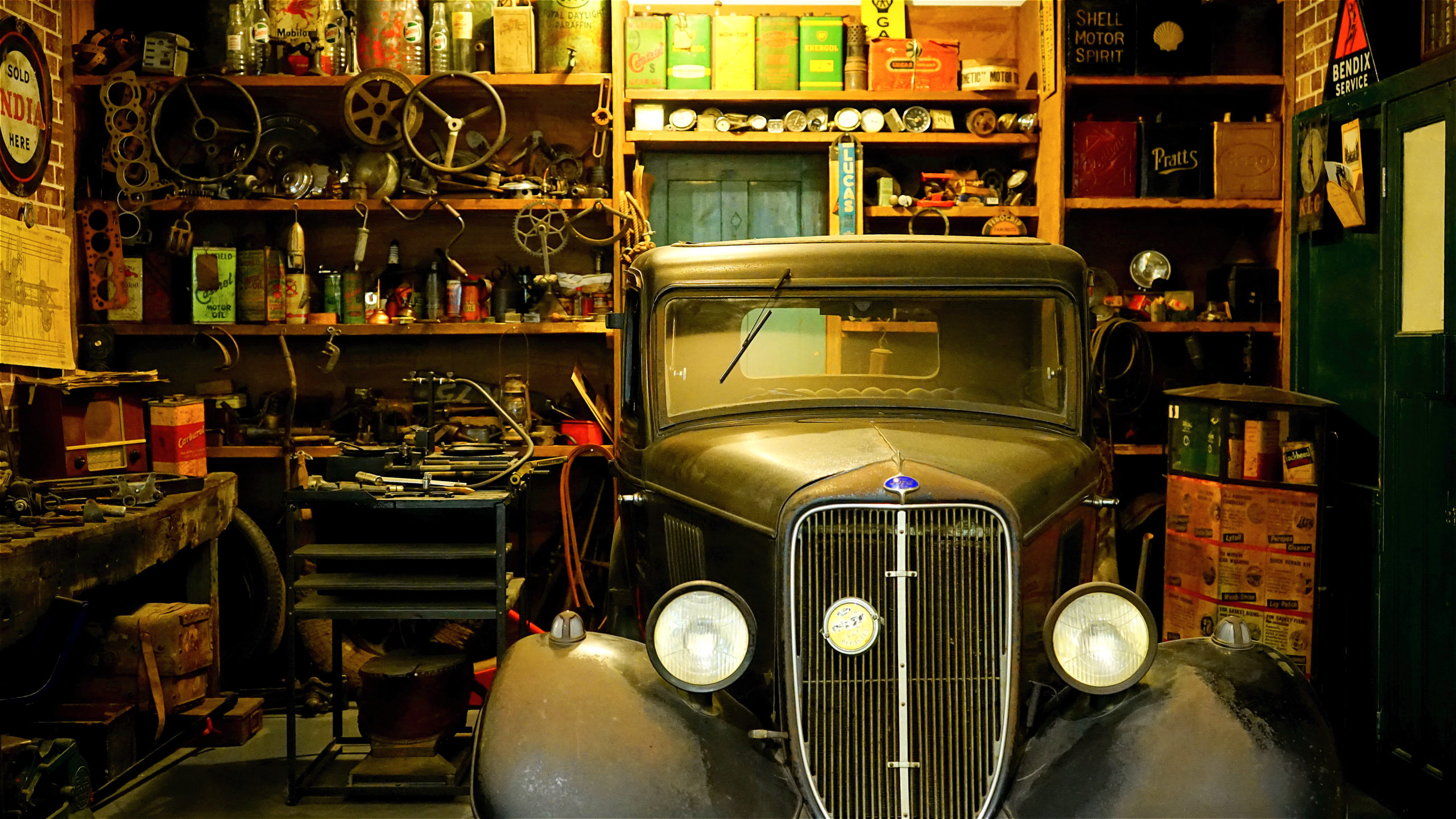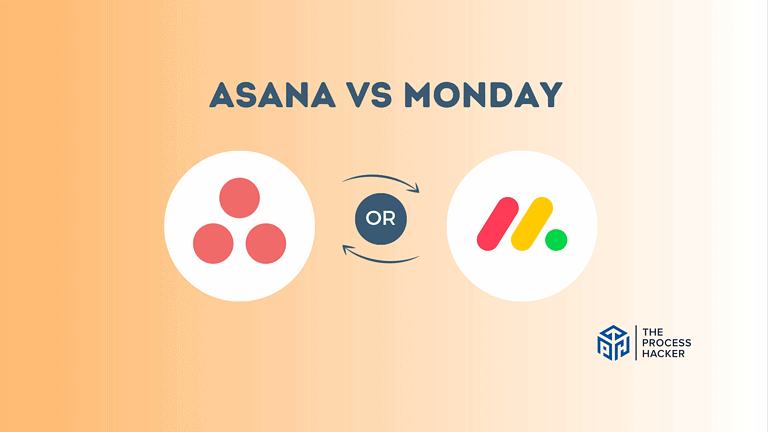5 Tips to Organize Your Work Space
“Clutter is caused by a failure to return things to where they belong. Therefore, storage should reduce the effort needed to put things away, not the effort needed to get them out.”
Marie Kondo is a well-known tidying expert from Japan who wrote the book, The Life-Changing Magic of Tidying Up.
It may seem that we have a lot of control when it comes to getting our work done; however, our work space play a significant role in the tasks and big rocks that we want to get done, especially in regards to deep work.
Like the photo shown above, I grew up with a messy garage with things everywhere – power tools laid on top of each other, the nail/screw drawers were a mash-up of various sizes, and the gardening hose always had to be untangled. Sometimes, I would back the car out of the garage to hopefully find the things I was looking for.
The clutter was frustrating at times. Over the years, I spent a lot of time dealing with my garage, causing me much lost productivity.
Thus, your environment has a significant impact on your behavior and the work you want to get done. You respond and take action based on how you organize your work space around you. You can redesign your work area to set yourself up to be productive using a Japanese organizational system, known as ‘5S’.
The 5S Methodology
‘5S’ is a system that allows you to organize your work space to be tidy, organized, and visual. By going through the five’ S’ phases, you will be more organized such that all tools and materials are put back in their appropriate places. The methodology establishes standard working conditions and systems while eliminating waste and safety hazards.
5S Terms and Translations
The 5S system of work space organization comes from five Japanese words that start with the letter ‘S’. The 5S system is derived from lean principles. The table below translates the Japanese terms into English with a respective definition:
| Japanese | English | Definition |
|---|---|---|
| Seiri | Sort | Remove all items that are not needed by separating needed tools, parts, and instructions from unneeded stuff. |
| Seiton | Set in Order | Organize needed items by arranging and labeling materials and tools for ease of use. |
| Seiso | Shine | Clean the work space. |
| Seiketsu | Standardize | Document procedures to maintain workplace organization for the first three S’s |
| Shitsuke | Sustain | Make a habit of maintaining the 5S organization through following established procedures. |
Example: Disorganized Garage Workshop
Disorder and filth will lead to lost time looking for things, errors from using the wrong tools, or getting hurt more often from physical hazards. A clean, orderly, organized work space will promote our focus on the task at hand and motivate us to use the space, which will make us more productive at the end of the day.
The image below shows a chaotic garage workshop bench. Would you want to use it?

Throughout this post, we will reference the garage as an example of a work space that we can organize and tidy up using the 5S methodology.
Sort
Sorting is to remove all items that are not needed by separating needed tools, parts, and instructions from unneeded stuff.
First, we remove all the things in our work space that we do not need. Yes, we will get rid of items that we will never need. However, we will also separate things that are really required versus those items that we use infrequently or have “just in case.” In your home, this could involve sorting out the unworn clothes in your closet, the broken electronics in the attic, or the tools collecting dust in the garage.
The advantages of sorting are that the work space gets uncongested, less time used to search for things, and the workplace is free from unnecessary items and storage space. A 2011 study by the Princeton University Neuroscience Institute found that clutter made it difficult for people to focus their attention on a given task. The unnecessary objects in one’s field of vision would be overwhelming to their visual cortex, which made it difficult for that person to focus on a particular task and be productive.
Steps:
- Identify the purpose of the work space.
- Divide work items into two categories: necessary (use) or unnecessary (not used).
- Subdivide work further items based on their purpose and time usage (frequently, occasionally, or rarely).
- Remove unnecessary items by trashing, repurposing, or donating.
Garage Workshop Example:
- I establish the purpose of my garage. It will be a place to store my car and the materials or tools that will help me to work on my home and yard.
- With the purpose (Step 1) in mind, I start diving through the clutter. I find that I am storing many unnecessary items like old boxes, broken electronics, and random junk.
- With the tools and materials that I use left, I begin separating them by how of their function and how often I use each tool.
- I remove, donate, or trash all of the items from Step 2 that do not align with the established purpose of the workspace.
Set in Order
Setting in Order or Straightening is to organize needed items by arranging and labeling materials and tools for ease of use.
Next, we arrange the items from the Sort phase for each use. We examine the purpose of each item and label them if required. Labeling is recommended for workplaces with many users to help everyone find, use, and return the items to their storage location. In an office, a central cabinet can be implemented to organize office supplies. There can be proper bins and labels to help all employees retrieve the appropriate supplies to get their work done.
The benefits of setting in order are to help all find the right items, reduce time searching for things, and have the appropriate space and location for each object. You can save up to 10X the effort of finding things when every item is organized appropriately.
Steps:
- Decide on a location for necessary items based on purpose and frequency of use.
- Obtain the appropriate storage containers and shelves to house the necessary items.
- Implement a visual workplace by labeling storage areas and locations.
Garage Workshop Example:
- With the newly created space from removing unnecessary items from the Sort phase, I have a lot of room to work with to organize my necessary tools and materials. Then, I sketch out a rough layout of how I want to organize the space with the tools and materials based on their purpose and frequency of use.
- I get a pegboard (shown in the image below) to store the tools I use most often on an easily-accessible wall. I get shelving for my power tools and storage bins with drawers for the nails and screws.
- For my pegboard (shown in the image below), I visually layout my wrenches by the specific type of wrench and in order of size/length, so it will be easy to find the wrench I need. I organize my nail and screw storage bin by type and size, and label the outside of each drawer, again for ease of use.

Shine
Shining or sanitizing is to clean the work space.
The third phase can be easy to disregard, especially when we get busy. Shining involves keeping the work space clean by vacuuming carpets, wiping down surfaces, dusting, sweeping, and mopping floors. This phase also includes putting away and maintaining materials and machinery to maximize operational time and prevent stoppages. Shining should be done regularly, so the work space is kept organized, clean, and equipment is in working order.
The advantages of cleaning your work environment are that problems are easier to detect, clean supplies are more durable and reliable. Also, it’s better for your motivation and health. Professor Nicole Keith, Ph.D., of Indiana University published a study to find that people with clean homes are healthier and more active than those with messy homes. The study followed the physical health of 998 elderly Americans to find that the cleanliness of their homes was closely correlated with their physical health even more than a factor like neighborhood walkability.
Steps:
- Conduct an initial or period deep clean.
- Determine the items that require regular cleaning with the type of cleaning required.
- Figure out how regularly the cleaning needs to occur.
Garage Workshop Example:
- As I have just organized from the last two phases, I will deep clean the garage to give extra attention to areas that are uncovered by the clutter and often neglected. I invest a full day removing dirt build-up, wipe every surface, and cleaning all tools.
- I determine that the power tools and workbench need to be wiped down. Also, the garage floor needs to be swept and mopped.
- I determine that the power tools and workbench have to be wiped down at the end of a day of use. Every other Sunday morning, I will sweep and mop the floor.

Standardize
Standardizing is to document procedures and task to maintain workplace organization for the first three S’s
The fourth phase allows us to establish procedures to continually carry out steps for maintaining the work environment such that it is kept organized, clean, and in working order. The U.S. Army defines a Standard Operating Procedure, or SOP, as “a clearly written set of instructions for methods detailing the procedures for carrying out a routine or recurring task or study.” SOPs are commonly used in the military and industry to help workers conduct activities consistently and efficiently.
The benefits of standardizing are that it will allow you to maintain an organized, working, and clean work environment using established procedures. It will be easier to train others to use the organized work space.
Steps:
- Establish the procedures needed for the Sort, Set in Order, and Shine phases.
- Define each procedure in as much detail required to execute the steps:
- What needs to be done?
- What materials or tools are required to do the work?
- Who will do it?
- Where is the work required?
- Implement the procedures such that the work space up to those standards.
- Make the procedures visible or easily accessible.
Garage Workshop Example:
- I write down high-level procedures for cleaning and gather any equipment manuals I can find for maintenance instructions.
- On my computer, I create checklists in Todoist or ClickUp for the cleaning required with details. Also, I download or scan the equipment manuals onto my laptop.
- Since I conducted a deep clean in the previous phase, the garage workshop cleanliness is up to my standards. Also, I use the manuals to fix and maintain all my tools, so they are in working order.
- Lastly, I organize a folder with my cleaning procedures and manuals in my cloud account such that they are easily retrievable.

Sustain
Sustaining is to make a habit of maintaining the 5S organization through following established procedures.
This final phase allows us to create the habits to maintain the organized work space using the procedures in the Standardize phase. We will look for ways to continually improve our work environment and update the procedures accordingly. Over time, we will get more work done and improve efficiency.
Steps:
- Assign roles and responsibilities for conditions set by the established procedures.
- Maintain and monitor conditions.
Garage Workshop Example:
- One of my closest friends asks me if she could get access to my workshop, so I agree as long as she helps with cleaning and maintenance. I give her access to the procedure files on my cloud account, and we split up responsibilities.
- Over time, the garage workshop stays clean and operational, and it’s an enjoyable place to work in!
Next Steps
If you have any further questions or need additional help, feel free to comment below or send me an email. Also, if you want more Process Hacker content, you should subscribe to our weekly newsletter on Productivity, Habits, and Resources.







